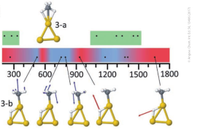Access Highlight at FELIX: Gold clusters - gentle bond breakers
|
a) General energy ranges for the vibrational modes of gold cluster– |
| The setup at FELIX used for the experiment |
Methane is currently the prime chemical feedstock for larger carbohydrates. The current industrial standard to produce these is to thermally crack methane into smaller molecules and then use these in a mixture called synthesis gas of CO, CO2 and H2 to produce the larger carbohydrates, again using plenty of energy. This energy consumption could easily be reduced if a direct chemical reaction from methane (CH4) to, for instance, ethane (C2H6) would be possible. Such a reaction requires a catalyst, which unfortunately has not yet been found.
Catalysts prepare the molecules that need to be chemically transformed into another by weakening certain bonds so that less energy is required for the reaction to succeed. On the other hand, they should not weaken too many bonds at the same time such that the original molecule is modified too much, or even completely destroyed. The working of a catalyst is generally dictated by this fine balance.
Researchers from Radboud University in Nijmegen, The Netherlands, Georgia Tech University in Atlanta, US, and Ulm University in Germany used infrared radiation provided by the FELIX free-electron lasers to find that tiny gold particles possess an important prerequisite for such a catalyst: in linking to the methane molecule, they selectively break one single C-H bond. Although gold in bulk form reacts very poorly with other substances (the reason why a golden ring never needs polishing) it can become chemically very active when it is reduced to a few-nanometre sized particle, or smaller. Once so small, the quantum nature of the particles starts to become very important, influencing many physical and chemical properties. When these properties change drastically by the addition or elimination of one single atom, the particles are usually referred to as ‘clusters’. Gold clusters were famously shown to catalyse the oxidation reaction of carbon monoxide CO, something that requires high tem- peratures in the absence of a catalyst.
Gold’s activity in the catalytic transformation of methane into larger hydrocarbons was known already, too. The partners from Ulm, who specialize in mass-spectrometric experiments measuring the kinetics of cluster-mediated reactions, had found that gold clusters can catalyse the formation of ethane, C2H6, from two methane molecules. They, and their colleagues from Georgia Tech, specialists in quantum-chemical theoretical description of such reactions, came up with a reaction mechanism that explained the observed kinetics. There was only one problem: they could not prove the mechanism experimentally, and needed a smoking gun.
The smoking gun came within reach, when the Ulm researchers ran into a FELIX scientist at an international clus- ter conference, ISSPIC in Leuven, Belgium. At FELIX, a team have specialised in infrared spectroscopic identification of clusters and their complexes with simple molecules. Over a Tripel Karmeliet, one of Belgium’s premium Trappist beers, the idea to identify the structure of one of the gold-methane intermediate products was struck.
The Ulm team made use of the Laserlab-Europe programme for transnational access to FELIX. Here, the joint team produced the gold clusters using laser vaporisation, and had them react with methane. The formed products were irradiated by intense infrared light from the intracavity free-electron laser FELICE, and then analysed using a mass-spectrometer.
Upon resonant infrared irradiation of a vibrational mode, the gold-methane product fragments, resulting in a depletion of the number of detected products. By recording the number of products as a function of infrared wavelength, a vibrational fingerprint of the product is found.
In these experiments, it was unambiguously demonstrated that methane molecules, when reacting with gold clusters, form a methyl (CH3) product. For this only one C-H bond of the methane needed to be broken. The use of FELICE was crucial to drive the absorption process for a product that is tightly bound; given the typical photon energies of 0.02-0.1 eV, and binding energies exceeding 2 eV, tens of photons need to be absorbed within a few microseconds.
So why is gold so special? There exist several transition metal elements that easily activate methane and break two bonds, releasing dihydrogen H2. These elements all have partially filled d-orbitals, which renders them very chemically active. Gold on the other hand has a completely filled d-shell, and should be mostly unreactive, yet it manages to activate methane by breaking just a single C-H bond. This 'gentle' breaking of bonds is attributed to relativistic effects of the gold electronic system, where an s-d hybridisation occurs. In the future design of novel catalysts, this fine balance can be a tuning parameter for the catalyst’s activity.
Joost Bakker FELIX Laboratory (Radboud University Nijmegen)


